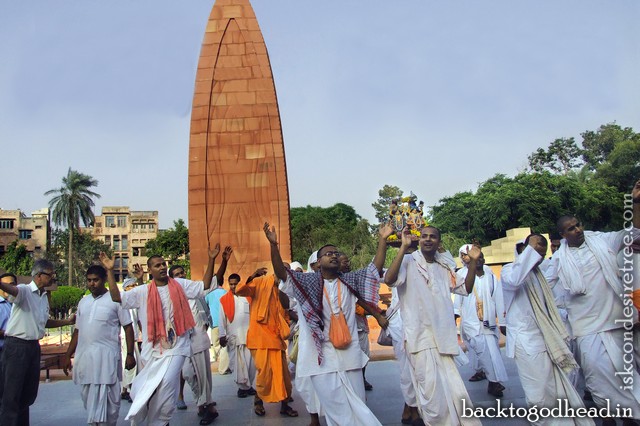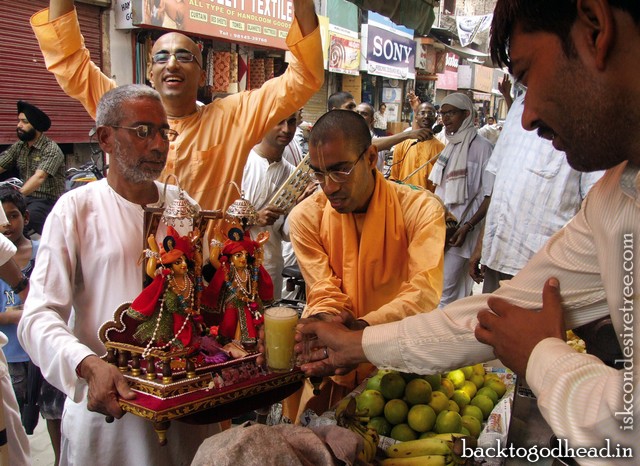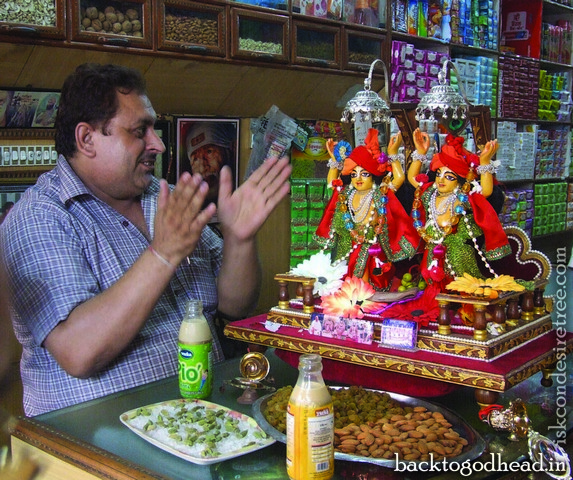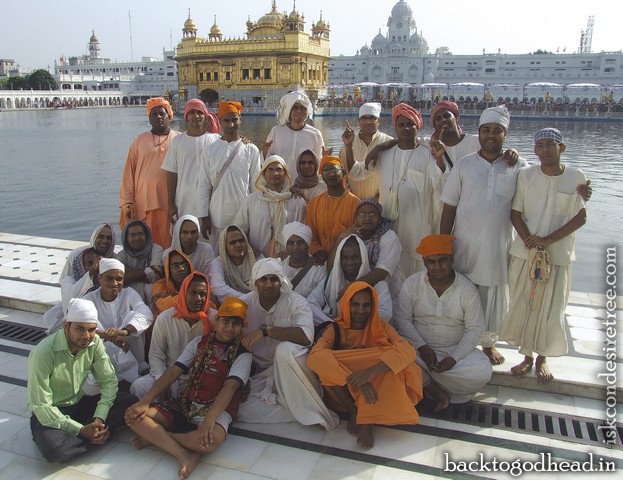With love and kindness, villagers welcome young Hare Krishna devotees carrying the holy name to their state.
Every year in our temple, ISKCON Chowpatty, as a part of the training program for the new residents, a few senior members of the brahmacari asrama lead the younger group to visit villages on foot in different states of India. To experience village life and Vedic culture, we travel without an itinerary. We perform kirtanas, give lectures, accept donations, stay overnight in schools or public lodges, and leave for the next village the following day.
In previous years we had visited Rajasthan and Odisha, where we felt welcomed in the natural culture of Krishna worship. Last year we decided to travel to Punjab, the most fertile land in India, which until a few years ago was a hotbed of terrorism. We knew it would be a challenge to be in the midst of the Sikh population. Yet depending on the Lord was also an important agenda of our travels.
With thirty-two devotees and attractive Gaura-Nitai deities (Caitanya Mahaprabhu and Nityananda Prabhu), we began our trip. Since last year was the five-hundredth anniversary of Lord Caitanya’s acceptance of sannyasa, we decided to emphasize harinama-sankirtana, the congregational chanting of the holy names of the Lord, which was central to Lord Caitanya’s mission.
Amritsar and Ferozpur
After spending two nights on a train from Mumbai, we reached Amritsar, the city of the magnificent Golden Temple. We began with a tour of the temple and the historic Jallianwala Bagh, the site of the gruesome massacre of Indians by British soldiers in 1919. From there we left for Ferozpur, on the India-Pakistan border.
Mr. Jitendra Mehra, the caretaker of a Radha-Krishna temple, met us in Ferozpur.
“Stay in Ferozpur for all five days,” he suggested, “and each day do harinama-sankirtana and programs. What is the need of going to the villages?”
But we had set our sight on the villages and settled for spending one day with him.
So our first public harinama of the trip took place in the streets of Ferozpur, and we were blown away by the response. Almost every shopkeeper made some offering in cash or kind for the deities. Some offered a garland of currency notes, some presented sweets, a goldsmith offered a silver bowl and spoon, from a pharmacy the Lordships received honey, from fruit vendors fruits and fruit juices. The atmosphere was full of joy and devotion. For a few hours we forgot we live in a world ruled by envy, competition, and greed. While the citizens of Ferozpur were enlivened to see thirty young men singing the holy names and dancing, we were enthralled to directly witness the mercy of Sri Caitanya Mahaprabhu.
The Indo-Pak Border
Thirty minutes from Ferozpur is the India-Pakistan border. Each evening soldiers of both nations perform a public ceremony. We wondered if we should go there. What would people think about seeing sadhus and Gaura-Nitai deities at the national border? And most important, would they allow us to do kirtana? Although skeptical, we decided to go.
An audience of Pakistanis sat on one side, Indians on the other. Amplifiers blared chants for the respective countries. As the soldiers performed their drill and stared down their opponents with hostile gestures, the crowd shouted patriotic slogans. Sri Sri Gaura-Nitai sat smiling on the lap of a devotee, witnessing the frenzied event.
Suddenly, the songs on the Indian side stopped.
“You can sing kirtana?” the soldiers asked.
We were jubilant. The atmosphere resounded with the holy names. Even the Indian soldiers swayed to the beats. It was a historic moment in this highly sensitive border post.
Later, as is customary, soldiers from each side came to the opposite territory and unfurled their nation’s flag. The devotee carrying Gaura- Nitai was on the edge of the Indian border. The tall, burly Pakistani ranger marched into the Indian territory, blew the bugle, and lowered the flag. Just then his eyes fell upon the deities; he was stunned, and his eyes filled with love. It was as if the eternal soul in that big, tough body achieved its constitutional nature as a part of God and was indescribably attracted to the beauty and mercy of Gaura-Nitai. We were enthralled to see that even though the soldier returned to his camp, he kept looking back at the deities.
Srila Prabhodananda Sarasvati writes, “Even though a person may faithfully perform pious acts or render incomparable service to Lord Visnu, his heart may still remain as hard as iron. Still, by Lord Caitanya’s mercy, even a person more sinful than a cow-killer may flood the universe with a stream of tears of pure love for Lord Krishna. Oh, when this happens, who can measure the intense happiness felt by golden Lord Caitanya?” ( Sri Caitanya-candramrta 127)
The First Village
The next day we reached Mamdot, a few kilometers from Ferozpur. Although we made no plans, it seemed that Gaura-Nitai had made arrangements for us. We met Mr. Janakaraja, who eagerly arranged for our stay in a temple. After hours of sankirtana in the streets of his village, we returned to the temple and asked the priest for some ingredients to cook.
His eyes widened, and he raised his hands to the sky.
“For the first time in the last sixty years,” he said, “Vaisnavas have come to this town to preach, and now you are saying you will cook on your own? Impossible!”
How could we refuse him? Immediately a team of four cooks began cooking for us.
In the evening we again performed harinama in the village and invited everyone for the night program. Almost 350 guests came. Addressing them in Punjabi, Dina Gopala Dasa raised an issue troubling many families in the state: drug addiction. Because it’s a border area, drug trafficking is easy there.
“We are having these problems,” Dina Gopala said, “because we have stopped chanting the names of God and stopped studying our scriptures, such as the Gita and the Srimad-Bhagavatam. If we do not submerge in the intoxication of devotion to the Lord, the intoxications of this world will overpower us.”
A local cable channel recorded our programs. The next day newspapers featured our stories. Thanking Janakarajaji and other villagers, we left for Khundra, a village ten kilometers away. We wanted to walk, but ignoring all our pleas, Janakarajaji arranged vehicles to take us.
Seeing the villagers’ respect for sadhus, we were flabbergasted. While in the cities sadhus are considered thieves, escapists, or lazy people, in the villages, because of some Vedic culture, sadhus are respected even today. The villagers’ respect reminded us of the need to be true Vaisnava sadhus ourselves, to protect the positive image created by pure souls over the centuries.
Srila Prabhupada’s Blessings
Villagers in Khundra were shocked to see the sudden arrival of thirty shaven-headed young men wearing dhotis and kurtas and singing and dancing. Initially people were skeptical and peered at us from their windows, as if we had landed from an alien planet. But soon they welcomed us with open hearts. We found the villagers to be simple and honest; perhaps that’s the reason it’s said that God resides in villages.
After the evening lecture, the villagers’ exuberant participation in the kirtana left us stunned. Later, as we rested at a nearby government school, a devotee read from the Caitanya-caritamrta (Madhya 7.82) about Lord Caitanya’s South India tour: “Upon seeing the chanting and dancing of Lord Sri Caitanya Mahaprabhu, Lord Nityananda predicted that later there would be dancing and chanting in every village.” While reading the purport, we felt Srila Prabhupada was encouraging and blessing us: “This prediction of Sri Nityananda Prabhu’s is applicable not only in India but also all over the world. . . . The members of the International Society for Krishna Consciousness are now traveling from one village to another in the Western countries and are even carrying the Deity with them. . . . If they follow the rules and regulations and chant sixteen rounds daily, their endeavor to preach the cult of Sri Caitanya Mahaprabhu will certainly be successful.”
An Unknown Friend
During our travels we usually tried to get some contacts and information before going to any village. At Khundra, however, we couldn’t decide where to go, so we just started walking. We walked eight kilometers, crossing lush green rice fields, and reached Lakhoke Bahrama.
Uncertainty loomed large on our faces. Where to keep the luggage? Where to organize the program? Where to cook? We went to a government school and got permission to store our luggage there. We then left for harinama-sankirtana. It was twelve noon, and the sun was blazing, yet the villagers enthusiastically took part in the kirtana. We begged for food, and they generously gave us rice, dal, and salt.
Sixty-year-old Ajaib Singh enquired about our program. While we were cooking with the donated ingredients, he and his friend Sukhbir Singh requested us all to have dinner at his place. Seeing his childlike enthusiasm and eagerness to serve, we were overwhelmed. His eyes shone with a father’s love, and when he learned we were planning to rest on the floor that night, he became concerned.
“How is it possible that sadhus come to our village and sleep on the bare floor?” he asked. “I will arrange cots for all of you.”
With great difficulty we explained to him that austere travel was not unusual for us.
“Okay, okay,” he said with a voice full of humility and persuasion, “I have emptied my house for you. Tonight you sleep there.”
We were tired after a day of hectic travel and had no strength to shift to a new place. We agreed that instead of doing the night program in the school, we would do it in his house.
Beyond Sectariansim
I went to check out Ajaib Singh’s house. He was a gracious host, and I instantly felt at home. We then began to discuss the saints of Punjab and how the Sikh gurus sacrificed their lives to protect sanatana-dharma. The tales were hair-raising. On refusing to convert to Islam, many of them were immersed in boiling oil, buried alive in walls, and crushed under spiked iron wheels. Why did they tolerate so much torture? I thought. Were they fanatics? No. They could have lived in peace by agreeing to convert, but being real ksatriyas, they knew that if the Vedic culture were destroyed, the entire social structure would collapse. To protect the sacred culture, they sacrificed their lives. As we heard these stories from Ajaib and Sukhbir Singh, sectarianism and religious dogma seemed trivial. We felt how vast devotion to the Lord is, far from narrow-minded, egoistic conceptions of God. Since God is the father of all, to think that only my path can reach Him is the height of pride and arrogance. When God, who resides in everyone’s heart, is pleased by a person’s sincerity and humility, He reveals Himself with all divine knowledge.
Suddenly Ajaib asked, “Do you know why I invited all of you to my house tonight? So that the whole night I can learn about God from you.”
His voice choked with humility.
“Tomorrow morning you will leave, and God knows when I will again get the association of sadhus.”
His character touched my heart deeply. We had met just a few hours earlier, and soon we would be separated, perhaps never to meet again. But his intimacy made me feel I was meeting an old friend. I also meditated on how the association of the sadhus he was hankering for was so easily available to me in ISKCON. I felt insignificant and humbled and hoped to realize the value of the association of devotees.
A Father’s Blessing And Prayer
The next day, as we prepared to leave, Kuldip Singh, a tall, muscular Sikh, approached us. His gentle demeanor was a striking contrast to his tough bodily appearance. He repeatedly begged us to visit his house for prasadam. But Ajaib Singh had already arranged it at his house. We decided to eat less at Ajaib’s house and stop at Kuldip’s house before returning to Ferozpur.
For breakfast Ajaib served hot alu-parathas, vegetables, pickle, and sweet lassi. He wanted to offer us everything he had. It was painful to part from him.
While leaving, we requested, “Since you are like our father, please bless us.”
“I have only one blessing,” he said in a faltering voice, “that you all become great saints. And I pray that just as you have come to our village to show us a glimpse of sanatana-dharma, you go to all villages and do the same.”
His eyes moistened. So did ours.
We then went to Kuldip’s home for kirtana and talks about Krishna consciousness. We were awestruck by the details he took care of in serving us. His family and neighbors also joined in kirtana.
I was reminded of another verse from Srila Prabhodananda Sarasvati’s Caitanya-candramrta (114): “In every home there is a tumult of hari-sankirtana. On everybody are tears, hairs standing erect, and other symptoms of ecstasy. In every heart is the most exalted and sweet spiritual path that leads far from the path of the four Vedas. All this has appeared now that Lord Caitanya has descended to this world.”
As we were leaving, Kuldip offered us a saropa (a shawl given to important guests) and a picture of prominent Sikh gurus. Though he didn’t talk much, he was the epitome of service and gratitude.
The day before, we’d been uncertain of everything, but when the journey ended, we realized it was the sweetest day of all our trips in the past. Treasuring these memories, we prayed never to forget them.
The simple villagers of Punjab taught us that we should always be eager to serve and that wherever we see true devotion, we should respect it, regardless of the caste, nation, or religion it may belong to.
While we were visiting the villages, Mr. Mehra had been requesting us repeatedly to spend our last day in Ferozpur. He had arranged programs for us. It was difficult to refuse. So we ended our trip at Ferozpur, with a nonstop kirtana for seven hours.
Vamsi Vihari Dasa is the assistant editor of Bhagavad-darshan, the Hindi edition of BTG.




